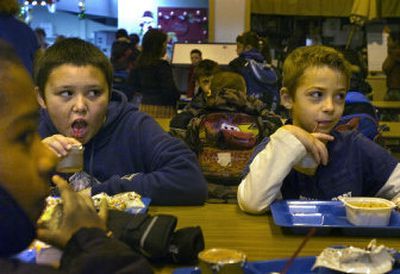Free school breakfasts a hot item

Demar Hadley squeezed a cheesy omelet between two fingers, and stuffed it in his mouth Friday morning at Garfield Elementary School.
“It’s goood,” proclaimed Demar, 9.
Usually flanked by his fourth-grade classmates, Demar eats breakfast in the school’s cafeteria every morning.
“The only thing I don’t like is they don’t give us enough,” said classmate Mykkal Herzog, 10. “I’m hungry, I can eat lots more.”
Mykkal isn’t the only child across the state wanting more breakfast.
Since the Legislature agreed to provide funding to eliminate the 30-cent breakfast co-pay for poor children, Spokane Public Schools have had 53 percent more children eating free breakfast each morning.
In the Central Valley School District, Spokane County’s second largest, more than 63 percent are showing up for the free meal, said Melanie Rose, district spokeswoman.
Statewide the increase is about 39 percent, officials with the sate Office of Superintendent of Public Instruction said.
“One of the barriers for kids getting a good breakfast has been reduced,” said Doug Wordell, director of nutrition services for Spokane Public Schools. “The kids who are able to get there and participate are getting a better start to the day.”
Under the federal school meals program, low-income families who qualify for reduced-price meals pay a maximum of 30 cents for breakfast, and 40 cents for lunch.
Last year the Legislature agreed to spend $2 million toward the breakfast program, of which about $1 million paid for the 30-cent co-pay, and the rest was used to pay school districts a higher reimbursement for the meals.
The Children’s Alliance, a statewide child advocacy group, has partnered with several other state organizations, including the Washington State School Nutrition Association, to ask the Legislature to pick up the tab for the 40-cent lunch co-pay next year, based on the increased participation in the breakfast program.
State school Superintendent Terry Bergeson has already requested an additional $1.5 million for the breakfast program, but not lunch.
“The 40 and 30 cents sounds like a little bit of money, but if you factor in that families often have two or three kids in the school system it mounts up,” said Linda Stone, Eastern Washington director of the Children’s Alliance.
Washington is the first state to eliminate the breakfast co-pay for students and, according to state data, some districts were already doing it – including schools in Tacoma, Federal Way and Renton.
In other states some districts have piloted a “universal meal program” in recent years, offering free meals to every child regardless of income.
“We know that children learn better when they are nourished,” Wordell said. For low-income children, the school lunch program provides more than a third of their daily nutrition.
“If they are focused on their stomach and where their next meal is coming from, they are not thinking about math.”